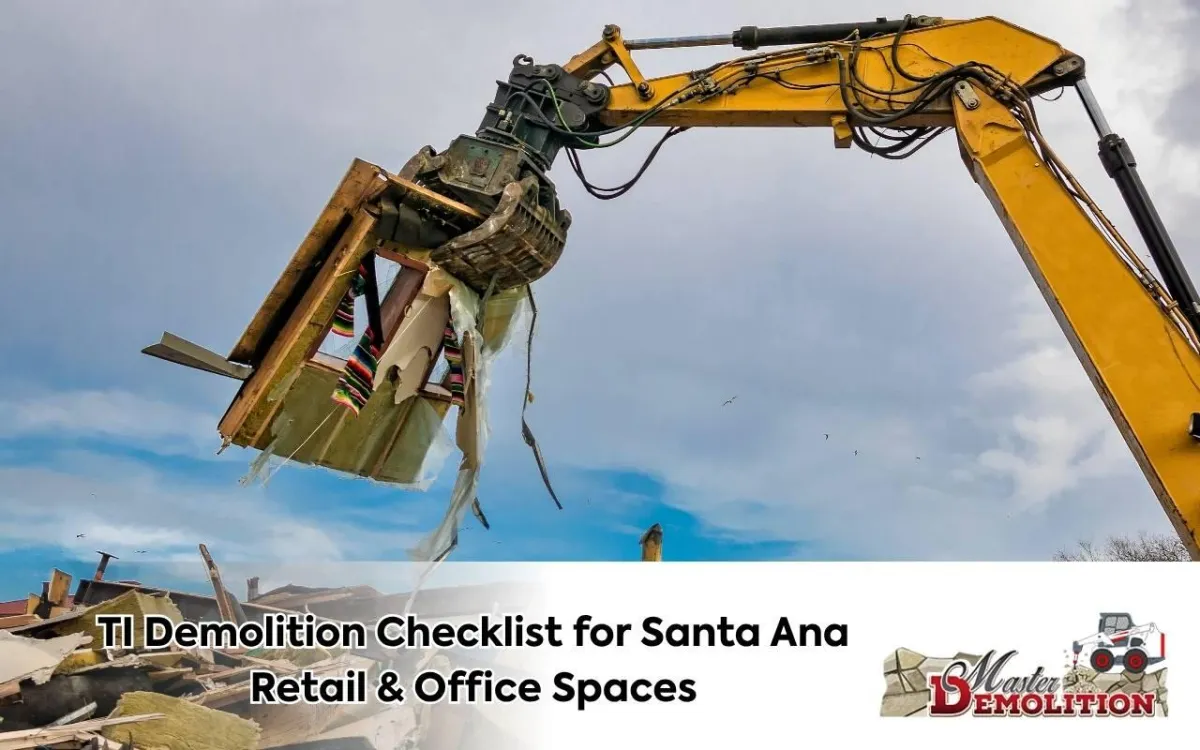
TI Demolition Checklist for Santa Ana Retail & Office Spaces
Undertaking a demolition project for retail or office spaces in Santa Ana is no small feat. It's a complex task that requires careful planning, precise execution, and attention to detail. One misstep could cause delays or even endanger workers. This is where a tenant improvement demolition checklist Santa Ana becomes indispensable. Whether you're clearing an outdated office for a new headquarters or revitalizing a retail space to attract foot traffic, having a structured plan ensures efficiency. Delving into selective demolition, it's crucial to balance removal with preservation. From protection plans to optimal scheduling, each step must be orchestrated carefully. Beyond finishing the work, a well-thought turnover process can define project success. Addressing these components transforms demolition into preparation for creation and innovation. For professional guidance, visit our demolition services California page.
Pre-Demolition Assessment and Planning
Before operating machinery, a thorough pre-demolition assessment is critical. This phase of your tenant improvement demolition checklist Santa Ana involves evaluating building conditions, checking for hazards, and reviewing drawings. Hire licensed inspectors for asbestos, lead paint, and other risks. Coupled with engineering reports, these findings create a safe plan. Define areas for full or selective demolition to preserve valuable features. Schedule stakeholder meetings to align timelines, budgets, and sequence of tasks. Include dust control, shoring, and safety signage. These measures save time and minimize unexpected costs.
Inspect for hazardous materials
Review architectural and structural reports
Establish scope of work
Set risk mitigation strategies
Obtaining Necessary Permits and Approvals
Securing permits is essential. Santa Ana requires applications for demolition, environmental clearances, and possibly preservation consents. Collect site plans, insurance certificates, and engineering reports before submitting. Early applications prevent delays. Stay in contact with municipal agencies to track code changes. If sidewalk closures or lane reservations are necessary, coordinate with public works. This proactive method creates a compliant demolition process without fines or shutdowns. Learn more by exploring our services page.
Demolition permits
Environmental clearances
Insurance and safety documentation
City coordination for traffic management
Creating a Detailed Protection Plan
Protection plans prevent damage to adjacent spaces. Outline shielding for walls, ceilings, floors, and utilities. Use plywood hoardings, scaffolding, debris netting, and protective cloths. Structural engineers guide the material choice and methods. Monitoring with vibration sensors or inspections ensures safety. Integrating these measures into selective demo allows neighboring tenants to operate normally and safely.
Shielding structures with hoardings
Installing reinforced scaffolding
Applying protective netting and cloths
Monitoring with vibration sensors
Coordinating with Demolition Contractors
Effective coordination determines project success. Vet contractors for certifications, insurance, and experience. Hold kickoff meetings to review plans and milestones. Use management software for task assignments and progress tracking. Regular check-ins solve issues quickly. Open accountability clarifies selective demolition boundaries. Proper coordination avoids overlaps and ensures safety remains a priority.
Establishing Optimal Work Hours
In busy retail or office districts, work hours matter. Coordinate with managers and tenants to identify times of low activity. Schedule work during evenings, weekends, or early mornings. Communicate schedules clearly to teams and subcontractors. Follow strict delivery and debris removal protocols. This respect for community minimizes complaints and improves relations.
Implementing Sustainable Demolition Practices
Sustainability aligns with environmental standards and may reduce costs. Conduct a materials audit to find reusable or recyclable items. Donate or recycle fixtures, lighting, and framing. Use eco-friendly demolition methods like wet cutting to control dust. Select low-emission equipment and biodegradable lubricants. Sustainable practices enhance reputation and community trust.
Managing Waste and Debris Removal Efficiently
Waste management is a vital part of any tenant improvement demolition checklist Santa Ana. Use correctly sized containers and regular pickups. Install sorting stations for concrete, wood, metal, and hazardous materials. Train crews to avoid contamination. Plan debris routes to minimize obstruction. Use enclosed lifts for vertical debris movement. Coordinate with haulers for timely pickups. This strategy maintains a safe and productive site.
Conducting Regular Safety Inspections
Daily safety inspections safeguard workers and neighbors. A safety officer should check barriers, lockout procedures, and PPE use. Log issues and resolve them within 24 hours. Schedule compliance audits at key milestones. These audits verify adherence to OSHA standards and local codes. Safety checks should always remain central in demolition planning.
Finalizing the Process and Turnover
As demolition ends, transition to turnover. Conduct walkthroughs with managers, tenants, and architects. Ensure selective demo areas are clear and hazards remediated. Complete any repairs promptly. Provide turnover packages with as-built drawings, certifications, waste manifests, and permit documentation. A clear turnover builds client confidence and prepares for the next phase.
FAQs
What is included in a tenant improvement demolition checklist Santa Ana?
It covers assessments, permits, protection plans, contractor coordination, safety inspections, and turnover procedures.
How do I prepare for a retail space demolition?
Start with inspections, hazard evaluations, and stakeholder meetings. Define a clear scope of work before demolition begins.
Why are permits necessary in Santa Ana?
Permits ensure compliance with building codes, environmental standards, and city regulations, preventing fines and delays.
How can waste be managed during demolition?
Set up sorting stations, use covered chutes, and coordinate pickups with haulers for efficient debris removal.
When should demolition work hours be scheduled?
Work hours are best during evenings, weekends, or off-peak times to minimize disruption for tenants and neighbors.
Ready to plan your project? Connect with our experts through our contact page today.